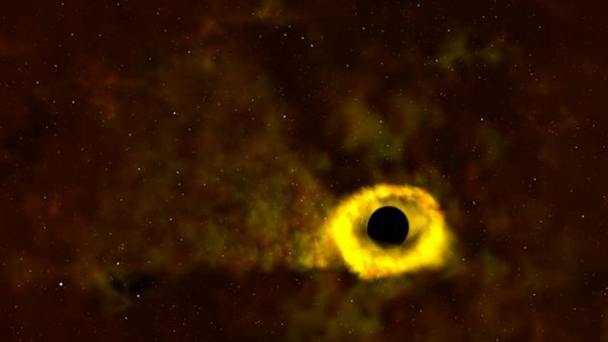Science and Technology
Context: Recently telescopes operated by National Aeronautics and Space Administration (NASA) observed a tidal disruption event named AT2021ehb.
- This is the fifth-closest example of a black hole destroying a star occurred 250 million light-years from the earth, in the centre of another galaxy.
- It was first spotted in March 2021, by the Zwicky Transient Facility in Southern California.
- It took place in a galaxy with a central black hole about 10 million times the mass of our sun.
About Tidal Disruption Event (TDE):

- It is a phenomenon of the destruction of a star by a black hole.
- Gradual growth of this material bound to the black hole produces a short-lived flare of emission, known as a ‘Tidal disruption event’.
- Tidal force: It is a difference in the strength of gravity between two points.
- If it is greater than the intermolecular force that keeps it together, the body will get disrupted.
- Tidal force of a black hole disrupts the star in vicinity.
- About half of the star’s debris continues on its original path, the other half is attracted by the black hole’s gravitational pull.
- TDE provides spectacular view of the corona’s formation and evaluation.
About NuSTAR Mission:

- The Nuclear Spectroscopic Telescope Array, or NuSTAR, mission studies the universe in high energy X-rays to better understand the dynamics of black holes, exploding stars and the most extreme active galaxies.
- In addition to complementing astrophysics missions studying the universe in various spectra, NuSTAR, the first hard-focusing X-ray telescope to orbit Earth, is expected to greatly improve on observations from ground-based observatories.
- NuSTAR science discoveries and highlights:
- First measurement of black hole spin with high precision
- Untangling the mystery of how stars explode
- The discovery of a shockingly bright dead star
- Staring deep into the hidden lairs of black holes
- Contributed to the first picture of a black hole.
Source: The Hindu
Previous Year Question
Q.1) If a major solar storm (solar flare) reaches the Earth, which of the following are the possible effects on the Earth? (2022)
- GPS and navigation systems could fail.
- Tsunamis could occur at equatorial regions.
- Power grids could be damaged.
- Intense auroras could occur over much of the Earth.
- Forest fires could take place over much of the planet.
- Orbits of the satellites could be disturbed.
- Shortwave radio communication of the aircraft flying over polar regions could be interrupted.
Select the correct answer using the code given below:
- 1, 2, 4 and 5 only
- 2, 3, 5, 6 and 7 only
- 1, 3, 4, 6 and 7 only
- 1, 2, 3, 4, 5, 6 and 7














